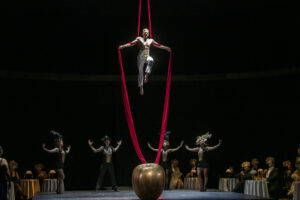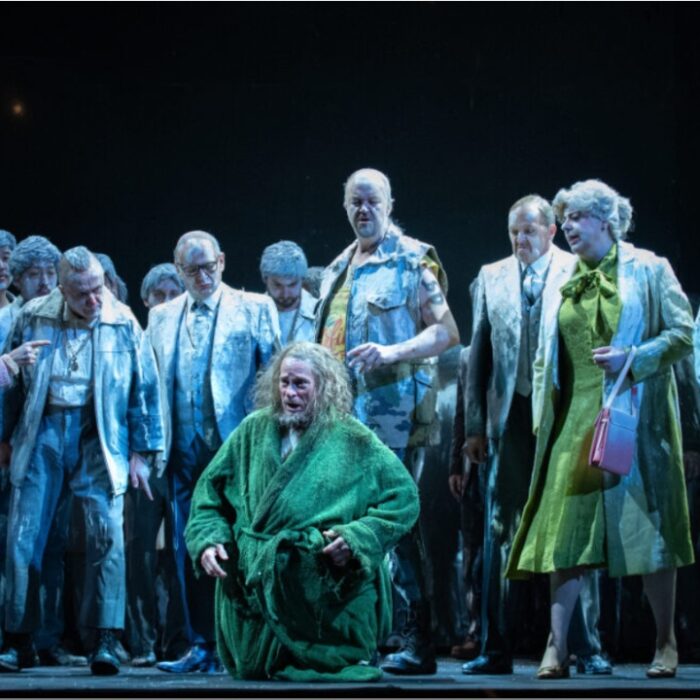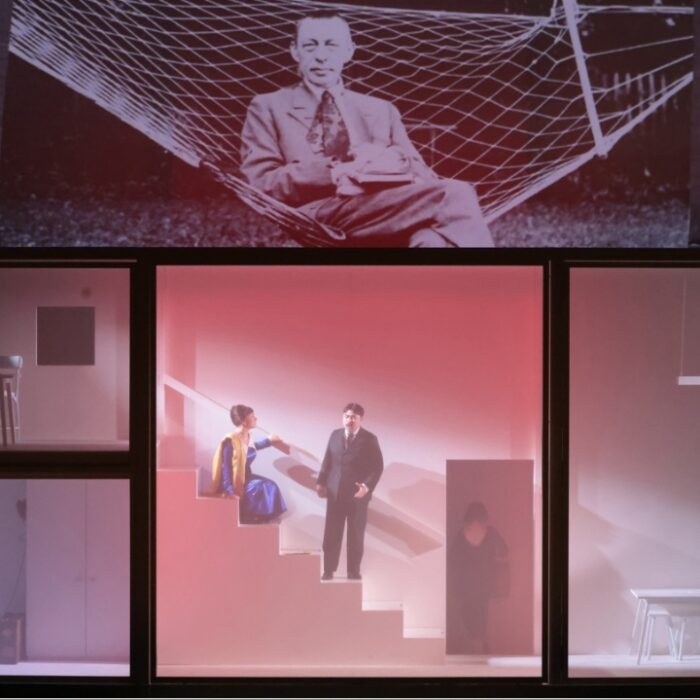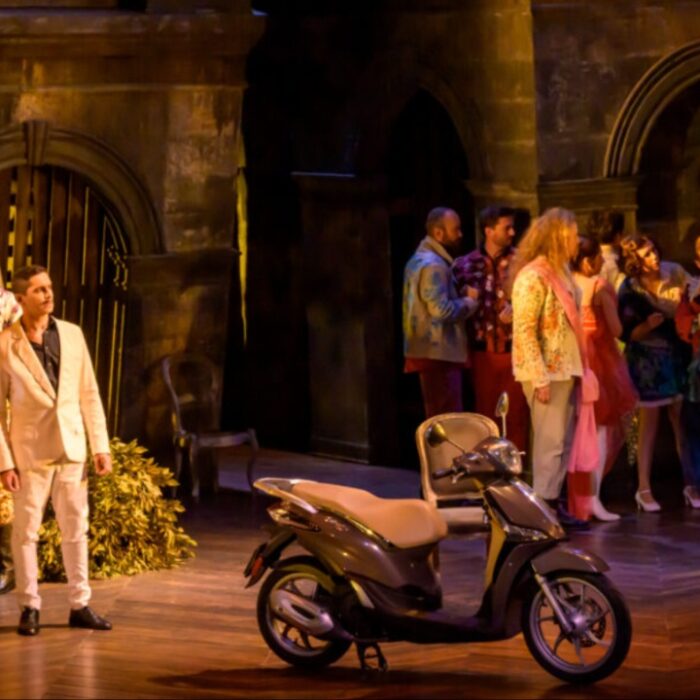
Opera Australia 2023 Review: Adriana Lecouvreur
Ermonela Jaho & Michael Fabiano shine in imaginatively designed production.
By Gordon WilliamsPhoto: Guy Davies
It is common for a theater to wait until “a suitable break” in a performance to admit latecomers. Still, it’s a shame some of the audience for Opera Australia‘s matinee performance of “Adriana Lecouvreur” at Sydney Opera House on Feb 25th missed out on the great Albanian soprano Ermonela Jaho’s ‘Io son l’umile ancella.’
This aria, touted by Opera Australia as the opera’s “big hit,” establishes the title character Adriana as one of the finest actresses of her age, the “humble servant of a work’s brilliant creator.”
But additionally, this number presented to us within the first 10 minutes, Jaho’s extraordinary range, from the declaimed lead-up to the ringing climax, a real tour de force.
Adrienne Lecouvreur was a real person, a star of the 17th century, whose real-life romance with Maurice de Saxe and her death, supposedly poisoned by her rival, Princess Bouillon, served as the basis for composer Ciléa’s storyline.
Not to worry. There was plenty else to savor, both musically and otherwise, in this fine production conducted by Leonardo Sini and directed by Rosetta Cucchi. In fact, Adriana recalls this number later, and there in Act three, you could appreciate other qualities in Jaho’s interpretation – a new edge in the delivery (to this reviewer’s ears) perhaps denoting a less humble attitude to the text, more appropriate to a successful actress of a later age.
And for this, you need to know that Cucchi’s production (a co-pro with Teatro Comunale Bologna and Fundación Opera de Oviedo) time-traveled through various periods starting out in the 18th century at the Comédie Française – as Ciléa and his librettist Colautti specified – but ending up in the rebellious 1960s, of which more later.
Ermonela Jaho Sparkles Amid Star Cast
Jaho was unarguably the draw card for this show. Undoubtedly, Francesco Ciléa’s 1902 opera largely survives to the present day thanks to the strength of singers like Jaho, who can do justice to such a role as Adriana.
But Jaho was supported by a fine cast. From the swirling ebullience of his opening number, ‘La dolcissima effigie,’ tenor Michael Fabiano established Adriana’s suitor, Maurizio, as a passionate lover.
Italian baritone Giorgio Caoduro was a wonderfully sympathetic Michonnet, the intendant of the Comédie Française, also in love with Adriana, while Romanian soprano Carmen Topciu was a formidable rival to Adriana as the Princess.
Australian bass Richard Anderson and Australian-Italian tenor Virgilio Marino, as the almost inseparable Prince and Abbé, were a staunch double act, capable of presenting a light touch as when the Princess named the Abbé as a witness to Maurizio’s wounding in a duel (to trick a reaction out of Adriana), and Marino’s ‘Io? (I was?)’ was an amusingly lame response to being so incorrectly and mischievously identified.
There was much to savor in ensemble moments. The opening hustling and bustling of backstage at the Comédie Française before a production of Racine’s “Bajazet” was very nicely managed and coordinated, and the female ‘Sleep’ chorus during Act three’s ballet produced an entrancing sound.
You can’t help but marvel at the beauty of Francesco Ciléa’s score. For that, the credit must go to the Italian conductor Leonardo Sini’s persuasive ebb and flow while delineating the structure.
An Opera in Search of a Plot
“Grove’s Dictionary of Music and Musicians,” claims that Ciléa selected “Adriana Lecouvreur” as operatic subject matter for its “mixture of comedy and tragedy, its 18th-century ambiance, the loving intensity of its protagonist and the moving final act.” Fair enough, but people around me at the intervals definitely had trouble working out the plot.
It’s fair to say the characters fail to intersect adequately with each other to summon a convincing picture of the heartbreak that results from vying for Adriana’s hand. There is also a political subplot that doesn’t quite gel. And key events do not adequately have their moment. Blink, and you might miss the poisoned violets. Or, indeed, the shock and recovery at the fake news of Maurizio’s wounding.
But it was a production that produced four Acts that pleased the eye in the hands of Tiziano Santi, Claudia Pernigotti, and Daniele Naldi (set, costume, and lighting designers, respectively). And perhaps the loud outburst of applause that greeted the ending of the Act three ballet, ‘The Judgment of Paris, ‘ had something to do with that ballet’s elucidation of a romantic choice. However, the dancers, particularly the wing dancer and choreographer Luisa Baldinetti and aerialist Brendan Irving, were most impressive.
Imaginative Directorial Vision Realized
Definitely, the change of periods gave each of the three designers a chance to display their wares with virtuosity; the black and white of Act three being particularly striking.
But it was the work of director Rosetta Cucchi that most intrigued me. “Her inspirations run the gamut from the opera’s original setting to more contemporary images of actresses,” said the program booklet. Cucchi set each Act in a different era – Paris in 1730 (the year in which the real ‘Adriana’ died), 1860, 1930, and 1968.
Clarifying? Perhaps not of the original plot, but introducing other ideas that might be just as intriguing. It seemed as if each Act became a meditation on an actress’s life (both backstage and under the proscenium) in each of the four periods. It was thrilling when Jaho, as Adriana in 1930, was obliged to recite lines from Racine’s “Phèdre,” and she basically showed us how operatic singing arose from the force of emotion behind declaimed speech.
Was there something in Cucchi’s approach to the Nietzschean idea of ‘eternal recurrence,’ the theory that we keep living our lives over and over again? We saw the same love triangle (or quadrangle) surface in each Act. And by finally moving that love-complex forward in Act four, Ciléa’s plot (too confusing in its original form, perhaps, to really hit all its emotional marks) finally became genuinely moving.
Act three (1930) introduced the idea of silent films. We saw, for example, Fritz Lang’s robot Maria (from “Metropolis,” 1927) behind the chorus sitting in a nightclub that made do for an updated Bouillon Palace, Ciléa’s original setting.
Venus in the ballet looked like her. But in Act four, when Maurizio offers Adriana his hand in marriage, he is merely a film image. She was now dancing with Michonnet, who perhaps truly loved her but was now the only character who had aged, a father figure as he was maybe always meant to be. Then again, a piece of counter-culture graffiti upstage read, “le temp est une invention des gens incapables d’aimer (Time is an invention for those incapable of love).”
Illuminating? Ironic? Perhaps both, but a reminder that there is always a benefit in seeing a thought-provoking and well-produced version of something that doesn’t quite work in its original form. And the music always carries us away.



